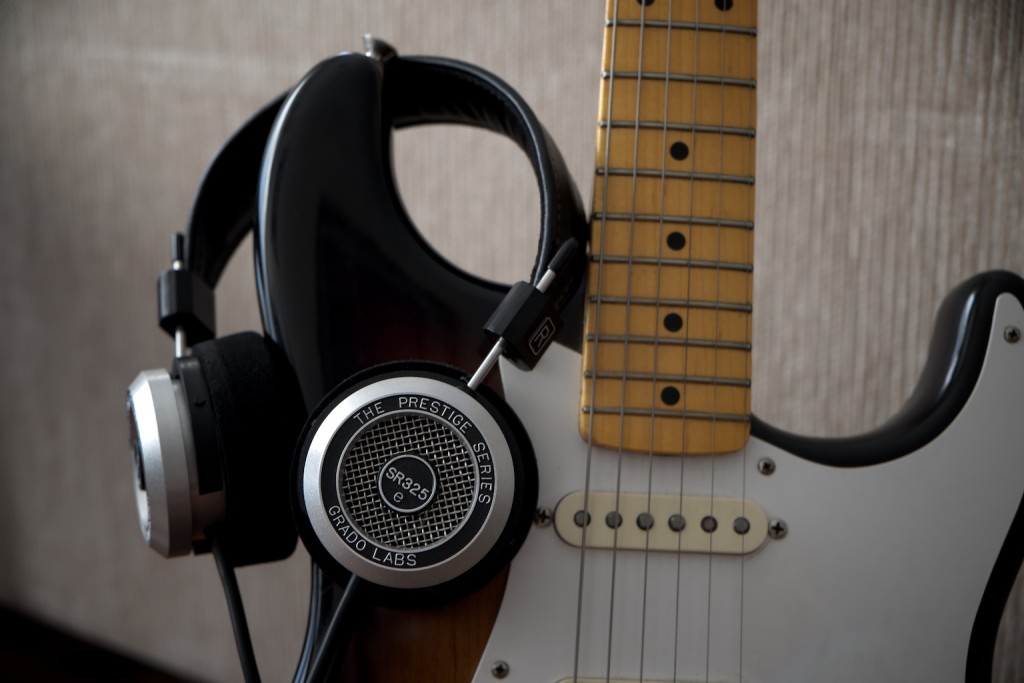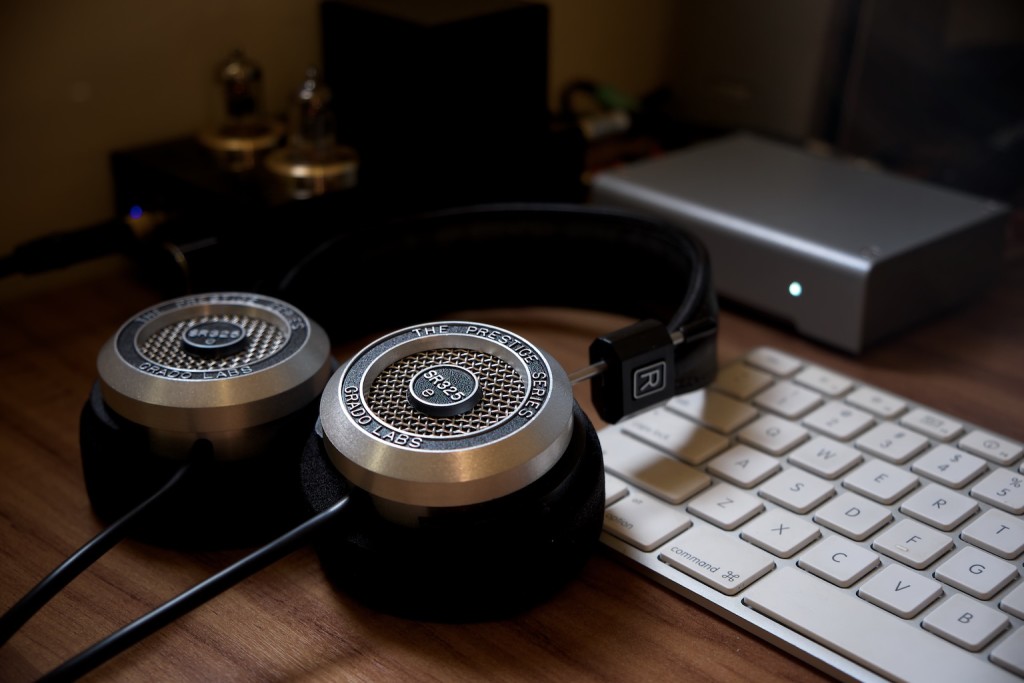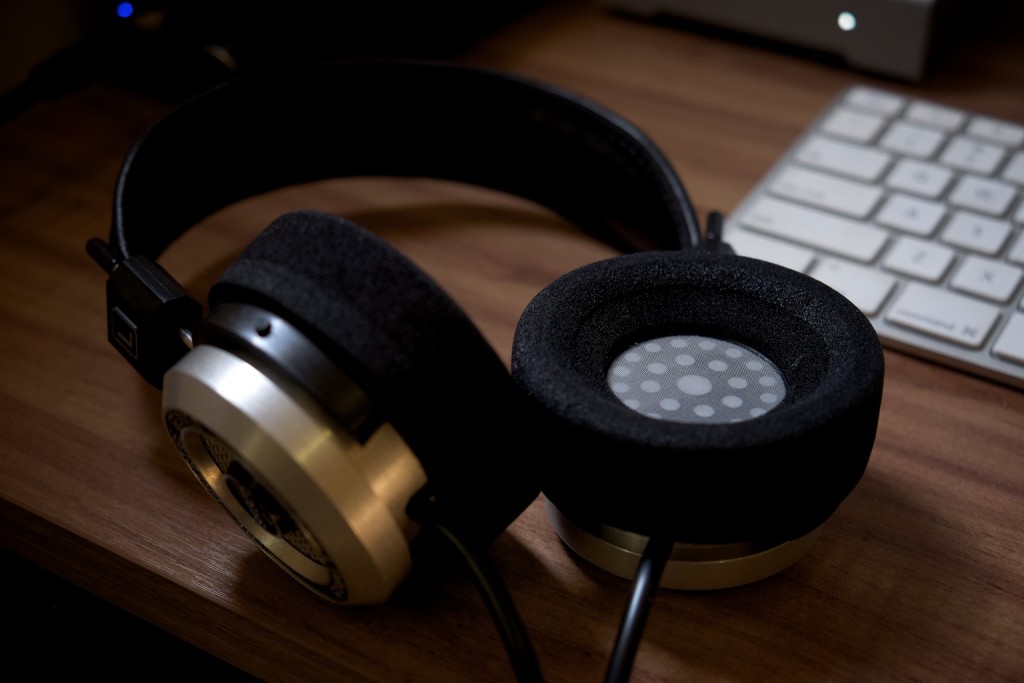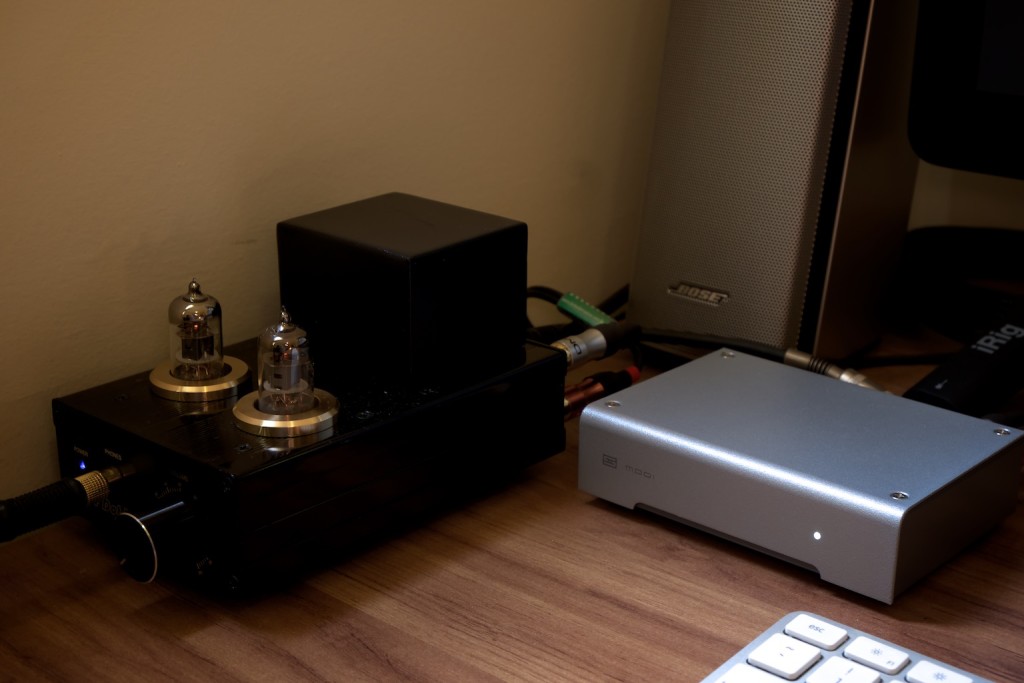
Grado refreshed its product line for 2014 and launched the e Series headphones. In case you’ve never heard about it, the small, Brooklyn-based audio company is considered one of the best in the business by audiophiles and enthusiasts. I have been using a Grado SR325e, the top-of-the-line model of its Prestige series and I would like to share with you my impressions of it.
This is the first time I review headphones, so bear with me. 🙂
Table of contents
Grado SR325e: the basics

The Grado SR325e looks exactly the same as its predecessors in the 325 series. Sturdy, well-built and featuring an all-metal housing and the familiar bowl-shaped foam earpads. The cables are virtually indestructible and are the same quality as a good instrument cable, which beats most headphone cables by far.
Some people with bigger ears might find the earpads on these headphones a bit uncomfortable when listening to music for long periods. For me, though, it is the perfect size. The Grado SR325e doesn’t make the ears too hot and I can use them even in this unbearable Brazilian summer.

The cable has a standard P2 connector, but since it is a beefy, high quality connector, it might not fit some smartphones, especially if you are using a case. The headphones also come with a P2 to P10 adapter to fit most audio amplifiers.
Bear in mind these are open headphones, which means sound leaks out. They are definitely not made for use in public and are more suitable for home use.
The complete technical specifications are:
- Transducer type: dynamic
- Operating principle: open air
- Frequency response: 18 – 24000 Hz
- SPL @ 1mW: 99.8dB
- Normal impedance: 32 Ω
- Driver matched dB: 0.05 dB
Test methodology
Although evaluating music is completely subjective, evaluating sound quality isn’t that much. There are some guidelines which help us determine if an audio equipment is good or not. Here is how I tested.
Audio equipment
The Grado SR325e has an impedance of 32 ohms, which means that it is a much bigger load than the typical earbud used with smartphones. As a comparison, Apple’s Earpods have a 23 ohms impedance. A good audio circuit in a smartphone is capable of easily driving most earbuds, but for most headphones, they lack power. Well, not really lack power, but you have to listen at volumes where THD is noticeable.
For that reason, and the fact that an open headphone is not meant to be carried around, I am using a proper amplifier for this test. I am powering the Grado SR325e with a Little Dot I+ hybrid amplifier. It has a tube stage running in Class-A (two 6JI tubes), a MC33078 op-amp for voltage amplification and BD139/BD140 transistors for output buffers. For this load (32 ohms), it offers a power output of 800 mW, which is more than enough. If you are interested in the complete specifications for this amplifier, please read here.

The amplifier’s input is connected to a dedicated digital-to-analog converter (DAC), a Schiit Modi. This unit is capable of decoding up to 96 kHz/24 bit audio, which is enough for this test. The reason I am using an external DAC is that I was not happy with the DAC in my devices. Throughout this review, I will also give my impressions using the DAC of my devices for comparison purposes.
The audio source is a FLAC library in VLC. The DAC is connected via USB to my 15″ Retina MacBook Pro.
I am using custom-made RCA cables between the amp and DAC, properly shielded and with gold-plated connectors for best audio quality.
In case you are curious, this setup costs (sans MacBook 🙂 ) around $550, headphone included.
Reference Tracks
For this test, I selected a few albums from various musical genres in order to explore all the possibilities with the Grado SR325e. When testing audio equipment, it is always good to look for good recordings — not necessarily good music (for your taste).
The first criteria was to have a good enough dynamic range. So, I started by taking a look at the Dynamic Range Database list. From there, I listed everything I had in my hard drive, among CD, LP, DVD and Blu-ray rips. Since I have a very large collection of music in physical media (700+ titles), it wasn’t very hard to come up with a big list. All my files were converted to digital FLAC lossless format, either at 44.1 kHz/16 bit (CD rips) or 96 kHz/24 bit (LP, DVD and Blu-ray rips).
I first eliminated all the mono recordings. Yes, some LPs I have from the 1950s to the 1960s were recorded in mono.
Then, I ran the tracks through a quick waveform inspection to look for clipping/saturation and removed those which were bad.
Finally, I ran the tracks through a stereo analyzer and removed the unbalanced ones. That gave me the following list:
- Claudio Abbado and the Wiener Philharmoniker, Mahler: Symphony No. 3 (1984 CD rip, 44.1 kHz/16 bit)
- Daniel Barenboim, Chopin: The Complete Nocturnes (1998 CD rip, 44.1 kHz/16 bit)
- Diana Krall, Stepping Out (1993 CD rip, 44.1 kHz/16 bit)
- Dire Straits, Dire Straits (1978 LP rip, 96 kHz/24 bit)
- Eric Clapton, Unplugged (1992 CD rip, 44.1 kHz/16 bit)
- Herbert Von Karajan, Anne-Sophie Mutter and the Berliner Philharmoniker, Beethoven: Violin Concerto in D, Op. 61 (1985 CD rip, 44.1 kHz/16 bit)
- Led Zeppelin, The Song Remains the Same (1976 LP rip, 96 kHz/24 bit)
- Megadeth, Countdown to Extinction (1992 LP rip, 96 kHz/24 bit)
- Metallica, The $9.98 CD: Garage Days Re-Revisited
(1987 CD rip, 44.1 kHz/16 bit)
- Muddy Waters, Folk Singer (1964 LP rip, 96 kHz/24 bit)
- Pink Floyd, Delicate Sound of Thunder (1988 LP rip, 96 kHz/24 bit)
- The Police, Reggatta de Blanc (1979 LP rip, 96 kHz/24 bit)
- Rush, Moving Pictures (1981 LP rip, 96 kHz/24 bit)
Evaluation criteria
During the tests, I am looking for:
- Good dynamics
- Low distortion
- Good spatial separation (stereo)
- Clarity
- Tonal balance
The test
Listening to music
Let’s start by my evaluation of Mahler: Symphony No. 3 recording, by conductor Claudio Abbado and the Wiener Philharmoniker orchestra.
When I first listened to this on the Grado SR325e, I paused at 30 seconds and listened again the opening in loop about 10 times. The opening played by the horns sound crystal-clear and spacious, filling the entire “concert hall”. The timpani plus strings ensemble chords are powerful and tight. And the crash cymbal at the end of the phrase is crisp and clear. This is the closest I’ve ever got to the live performance.
The following bars feature a very delicate, pianíssimo phrase on the timpani. This is impossible to hear in earbuds and even on average full-sized headphones, you have to be listening quite loudly to grasp it. Not in the SR325e, though. The phrase is perfect: discrete pulsation, nearly silent, making way to the brass on the next section of this piece.
These few opening bars of Symphony No. 3 gave me an idea of what these headphones are capable of. Throughout the 100 minutes of this piece of music, all qualities of the Grado SR325e became clear: the fortissíssimo part in the grand finale of the 1st movement was clear and not distorted; the post horn in the distance in the 3rd movement sounding really far from the rest of the orchestra, showing the great stereo imaging in these headphones; the clear vocals and choir on the 4th and 5th movements.
For those who like orchestral music, the Grado SR325e is a great choice, especially because of the spacious stereo imaging and great dynamics — it won’t distort in fortissíssimo and yet will allow you to listen to pianíssimo.
If you prefer music with vocals, no problem. The midrange in the SR325e is the best in the Prestige series. For me, it is what changes the most from the SR60e all the way to the SR325e. Although the SR60e is great, after you go up in the line, you can’t go back because vocals are gradually much more powerful and clear. Take Diana Krall’s Stepping Out, Muddy Waters’ Folk Singer or Eric Clapton’s Unplugged, for instance. These recordings have a somewhat thin instrumental section (just a few instruments), which makes vocals stand out — and they are crystal clear. The bass is there, without being so punchy, and cymbals are crisp and very pleasant to hear.
Moving to live recordings, the Grado SR325e behaves exactly how one would expect: recordings loose the tightness of the studio space and get more spacious, yet without losing clarity. This is very noticeable when you compare Pink Floyd’s recordings of “Comfortably Numb” from The Wall and Delicate Sound of Thunder.
Heavy stuff, like Megadeth’s Countdown to Extinction sound good and well-defined, but some people will say they should sound more powerful. This is probably because the bass isn’t as punchy and pronounced as in closed headphones. I am not saying the Grado SR325e lacks bass. It just has a flat frequency response and it doesn’t emphatize bass, like Beats does, for instance. If you like a lot of bass, then these headphones aren’t for you.
Overall, it doesn’t matter the music genre: the Grado SR325e shines.
Practical stuff
Now let’s move to some everyday aspects of owning and using headphones.
The first thing you will notice is that the Grado SR325e is big. Big enough to become a nuisance when it comes to find a place for it to rest on your desk. So, a headphone stand is more appropriate for it.
Carrying the Grado SR325e around is also a problem. Size aside, it doesn’t come with a case or bag, so you will have to find one if you wish to carry it with you. This is probably not a problem for most people, as these headphones are meant to be used at home. But if you have two homes like me, then you have to find a solution for transport.
Next, audio equipment. You can definitely use it plugged to your iPhone, but the results are not the same as if you were using a good amplifier. The stereo imaging is much better when using a good DAC, like the Schiit Modi. As a result, on the iPhone 6, recordings feel a bit cramped and you can’t really tell the exact position of each instrument. On the other hand, bad recordings will sound really harsh through a good DAC — good audio equipment is not forgiving with bad recordings, which may spoil all your fun when listening to music.
Volume-wise, the iPhone 6 I am using is capable of driving properly the Grado SR325e at around 50% volume (-28.8 dB attenuation). At this level, a little bit of distortion is evident, especially in bad recordings. In order to keep distortion at inaudible levels, you have to leave the volume at around 4 clicks (-46.8 dB). And bear in mind that the iPhone probably has the best DAC in the mobile market since the iPhone 5S. For comparison, my Little Dot I+ amplifier is working at less than 10% volume, at a negligible THD level. One good reason to use a dedicated amplifier.
Finally, audio sources. I know most people don’t keep a FLAC library, as the files take too much space and require a lot of patience to rip from CDs and LPs. So, if you are listening to music from iTunes, Spotify or other digital/streaming sources, don’t worry. As long as the recording is good and the bitrate is high enough (192 or 256 kbps for a 44.1 kHz/16 bit recording is acceptable), you won’t get annoyed. You are missing some subtleness found in lossless audio files, but it isn’t so bad that you will only want to listen to FLAC. I am listening to Spotify as I type this review and I don’t feel like I want to break my computer because of audio quality of it 🙂 .
Bear in mind that bad recordings will sound harsh, regardless of source or audio equipment used to drive the headphones.
Conclusions
The Grado SR325e is great, period. Sound-wise, I cannot find any bad things about it. The only aspect of it I would change is comfort. There are more comfortable headphones in the market, like the AKG K551 or its own Grado SR80e, for instance. But that doesn’t make the SR325e uncomfortable.
I would only recommend against these headphones for people who:
- like a bass-heavy tone.
- prefer a laid-back tone, with attenuation on the treble/upper-midrange. This will make bad recordings sound less bad, but also make great recordings dull. It is a double-edged knife.
If you like a more airy, spacious experience that great recordings can bring, then the Grado SR325e is for you.